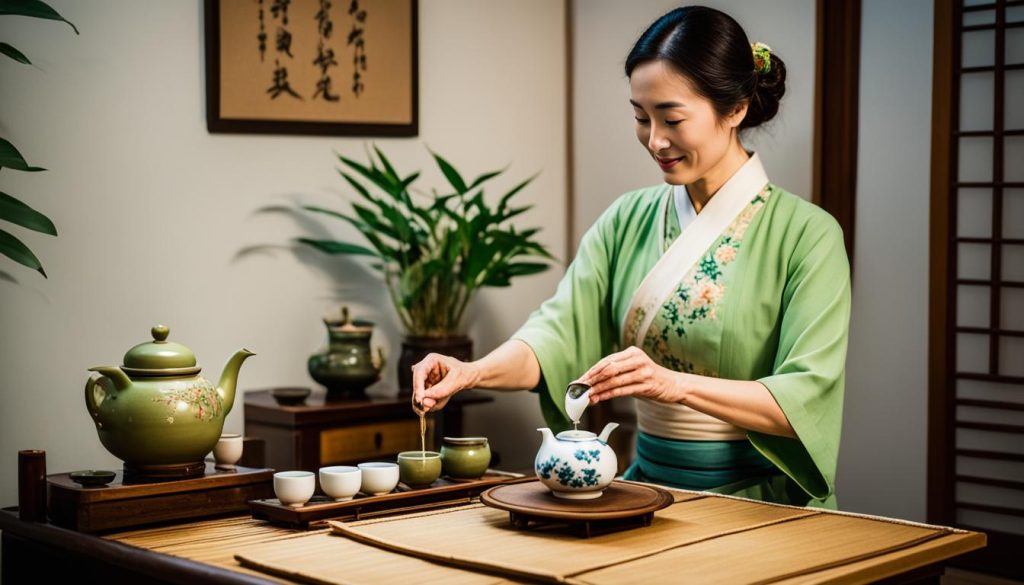Tea sets are more than just serving items in Asia. They stand for welcoming others, showing friendship, and connecting with the spiritual world. This article will look at how the history, customs, and meanings behind tea ceremonies influence Asian cultures. We aim to highlight the beauty and significance of tea sets in Asia, which can captivate anyone interested in learning.
Key Takeaways
- Tea sets in Asian cultures symbolize hospitality, friendship, and spirituality.
- Asian tea ceremonies have a long history and are steeped in tradition.
- Tea sets play a significant role in important life events such as weddings and funerals.
- Different types of tea have their own cultural and historical significance in Asia.
- Ceramic pottery is closely intertwined with tea culture in Asia, enhancing the aesthetic and sensory experience of tea ceremonies.
The History of Tea in Asia
Tea has a rich and fascinating story in Asia. It was first found in ancient China, around the 3rd century BCE. Back then, it was used for health reasons. But soon, people all over China loved it as a drink.
From China, the tea culture spread to Japan and Korea. In Japan, the samurai greatly enjoyed tea for its calming benefits. This led to tea ceremonies that celebrated peace and respect, called “Chanoyu” or “Sado”. These events focused on enjoying tea’s beauty and calmness.
In Korea, tea was important in religious practices. Buddhist monks used it to help with their meditation. They thought tea brought clear thinking and focus.
Tea kept changing and growing in Asia. Each place made their own special ways to enjoy tea. This shows how tea is more than just a drink. It brings people and cultures together.
Key Moments in the History of Tea in Asia
- 3rd century BCE: Tea is discovered in China and used for its medicinal properties.
- 6th century: Tea cultivation spreads to Japan through Buddhist monks.
- 9th century: The Japanese tea ceremony, Chanoyu, becomes more formalized.
- 14th century: The Korean tea ceremony, Darye, gains popularity.
- 17th century: European traders introduce tea to the Western world.
Tea has truly changed life in Asia, from social gatherings to showing art and culture. The history of tea is a deep part of Asian life. It is a strong link between the people and their traditions.
Cultural Significance of Tea in Asia
Tea is very important in Asia. It represents deep traditions and means of offering hospitality, friendship, and spirituality. Its customs range from Japan to China and more. These customs are part of daily and special events, showing its high regard.
The Art of Tea Ceremonies in Japan and China
Japan sees tea ceremonies as a true art in Chanoyu or Sado. These ceremonies are full of tradition, respect, and grace. Every step, like making and serving the tea, is done with respect and attention.
In China, tea ceremonies happen in vital events like weddings and funerals. Tea is a way to show respect and make everyone feel welcome. These customs highlight tea’s deep cultural meaning in China.
Religious Use of Tea in Asia
Tea is key in various Asian religions. In Tibetan Buddhism, it purifies the mind and body, vital for meditation. It’s a key part of spiritual rituals.
Across Asia, tea stands for quiet, mindfulness, and respect, connecting to the divine, and finding peace.
The Power of Tea in Asian Culture
Tea shapes harmony and peace through its ceremonies and traditions. It brings people and communities together.
Tea goes beyond a drink in Asia. It is a symbol of tradition, respect, and spirituality. It is seen in daily life and important events, showing its deep cultural value.
Types of Tea in Asia
Asia is famous for its many types of tea. Each one has special meaning in its culture and history. For example, Japan offers green tea with its unique ceremonies. Then there’s China’s oolong with its mix of green and black tea flavors. And not to forget India’s bold black teas, loved by many worldwide. Let’s dive into these teas and discover their stories.
1. Green Tea in Japan
Green tea is more than a drink in Japan; it’s a cultural symbol. They have a special ceremony for it called “Matcha.” The finely ground green tea turns hot water into a bright, smooth drink. This green tea brings not only delicate flavors but also a sense of peace and focus when enjoyed.
2. Oolong Tea in China
In China, oolong tea is a favorite, balancing green tea’s lightness with black tea’s depth. It’s a part of big celebrations like weddings, adding a special touch with its aroma and taste. This tea is loved for its complexity and the joy it brings to those who drink it.
3. Black Tea in India
India’s love for black tea is evident, especially from the regions of Assam and Darjeeling. This tea boasts a rich color and a strong flavor. Usually enjoyed with milk and sugar, it’s a key drink for many in India. It accompanies their day from early mornings to late afternoons.
The Preparation of Tea
Asian cultures have their unique ways of preparing tea, making each experience special. In Japan, the method for green tea is “temae”. This method involves precise actions, from measuring the tea to pouring it into a bowl. Doing this teaches people to focus on the moment and be calm. It guarantees a great taste and is a chance to slow down and meditate.
For oolong tea, China uses the “gongfu” method. Gongfu means skill, which shows how important making the tea is. A special teapot and small cups are used. The teapot brews leaves quickly, and the tea is poured in small amounts. This lets you enjoy the scent and taste deeply.
In India, black tea, called “chai,” is a lively experience. It’s made by boiling tea leaves in water mixed with milk and spices like ginger. The mix is simmered to blend the flavors, making a bold and tasty drink. Chai is key to socializing in India, offering warmth and chats among friends and family.
How is tea prepared in Japan?
Japan’s traditional way of brewing tea is called “temae.” It includes precise measuring and pouring the tea into a bowl. This method highlights the importance of being accurate, focused, and calm.
What is the “gongfu” method of tea preparation in China?
China’s “gongfu” method focuses on making oolong tea in a detailed and skilled way. It uses a special teapot and small cups. The teapot is filled with leaves and quick infusions are poured into the cups. This way, every sip is full of the tea’s inviting smell and taste.
How is black tea prepared in India?
In India, black tea or “chai” is made by boiling tea leaves with water, milk, and spices. Flavors are fused by simmering the mix. This creates a full-bodied drink with a pleasant aroma.

The Impact of Tea on Asian Culture
Tea has greatly influenced the many cultures of Asia. It’s more than just a drink. It represents friendship, hospitality, and spiritual connections. For centuries, tea rituals have been essential in Asian life.
Tea as a Symbol in Asia
In Asia, tea signifies warmth and sharing. It brings people together. Serving tea is a way to show friendship and welcome others. These actions carry deep values across Asian societies.
Tea also plays a role in diplomacy. In ancient China, offering tea was a symbol of peace between nations. Tea ceremonies were key in forging friendly international relations.
For spirituality, tea is important in Asian religions. Japanese and Chinese Buddhist monks use tea to meditate. It helps them stay mindful and find peace through tea rituals.
Tea in Weddings and Funerals
Tea ceremonies mark important life events in Asia. At weddings, they unite families and ask for blessings on the couple’s future. Giving tea shows respect to elders and ancestors.
In funerals, tea is offered to mourners. This tradition in China and Japan gives comfort to those who are grieving. It’s a way to remember and honor the dead.
This tradition shows tea’s connections between past, present, and future. It highlights the lasting traditions and values in Asian societies.
The Intersection of Ceramic Pottery and Tea Culture
Ceramic pottery is essential in tea culture, especially in places like China and Japan. Teapots, tea bowls, and cups are made with great skill and are a key part of preparing and serving tea. They add beauty and tradition to tea ceremonies and help us better enjoy our tea.
The Role of Pottery in Tea Ceremonies
Both China and Japan have rich tea ceremony traditions. In these rituals, every ceramic piece is chosen for both its look and use. Teapots are crafted to make tea taste and smell better. They absorb tea flavors, making each cup more complex. Handmade tea bowls and cups add warmth and beauty to the experience.
The Importance of Ceramics in Tea Drinking
Ceramic teaware is great for drinking tea because of how it interacts with the tea. The materials breathe, letting out scents and tastes. They also keep tea warm and look and feel nice. This makes every cup of tea a pleasure to drink.
Making high-quality ceramic teaware needs a lot of skill and care. People who make these items learn for years. They use special techniques and materials to make them perfect. These pieces are both beautiful and important in the tea world.

The mix of ceramic pottery and tea culture shows how beauty and function combine. Handmade pieces help make tea ceremonies special and carry on ancient traditions. Enjoying tea from these finely crafted items reminds us of a deep, rich history and makes tea time even more delightful.
Conclusion
Tea sets in Asia are not just objects; they carry deep meaning. They show centuries of tradition and are tied to the act of drinking tea today. These sets stand for welcoming others, building friendships, and connecting spiritually. They make tea ceremonies more beautiful and fill them with meaning.
The history and meaning of tea sets in Asia are truly special. From China’s ornate teapots to Japan’s delicate tea bowls, each piece tells a story. These items show off fantastic skill and care, which are famous in Asian cultures. For tea lovers, they’re more than just tools. They mark the beginning of a peaceful journey into the world of tea.
Asia’s love for tea is alive and well, from Japan’s detailed tea ceremonies to India’s joyous tea gatherings. Discovering more about tea sets in Asia will deepen your love for tea. So, take a sip of tea, feel its comfort, and enjoy the peaceful moments it creates.






